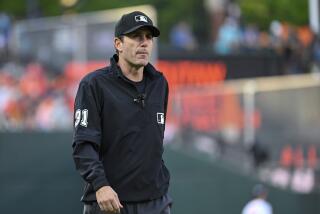Umpires get second look at homers
- Share via
While saying he still embraces his sport’s “human element” and its “pace,” Commissioner Bud Selig announced Tuesday that “the time has come” to create a place in baseball for technology by installing limited use of instant replay.
“There’s nothing that’s perfect in life, but the extraordinary technology will help us,” Selig said in a conference call with reporters.
Starting in three series that open Thursday, including the Angels’ matchup with the Texas Rangers, baseball will allow umpires to review replays of disputed home runs when there are questions about whether a ball was fair or foul, whether it cleared the fence, or was interfered with by a fan.
In a change to the game that some compared to the introduction of the designated hitter in the American League in the 1970s and wild-card playoff teams last decade, baseball officials said umpire crew chiefs can signal for a timeout in cases when they need to review a play. The crew chief will then review the “most appropriate video footage” from “all possible [television] feeds,” through Major League Baseball Advanced Media (MLB.com) in New York to determine the proper ruling.
Reversing an on-field call will require “clear and convincing evidence,” MLB officials said in a news release.
Selig said he expected replay to be used on only “a very limited basis,” and contended that reviews might take less time than when umpires convene to discuss a disputed call without the benefit of replay.
Baseball general managers voted 25-5 last year to use replay, and agreements were later struck with the umpires’ and players’ unions. The unions have the power to amend or ask MLB to halt replay after this season, a baseball official said.
“You want to get it right,” Dodgers Manager Joe Torre said. “I think it makes sense.”
Former Dodgers third baseman Ron Cey said replay was not an assault on the game’s purity, declaring, “Umpires make mistakes. You don’t want one of those plays to ruin the outcome of your game.”
Cey argued replay should be expanded to address controversial incidents like the no-call of basepath interference on the New York Yankees’ Reggie Jackson in a 1978 World Series game the Dodgers lost.
“If they review that, there’s a high chance we win the Series,” Cey said.
But Angels center fielder Torii Hunter wasn’t sold. “I’m more of an old-school guy,” he said. “I like the human decision of the umpires, whether it’s right or wrong. That’s what makes baseball. Guy might be safe and called out, all the fans get upset and scream, everyone jumping up and down. That’s kind of cool.”
A cluster of disputed homers in May boosted the outcry for the introduction of replay.
On May 18, plate umpire Bob Davidson and two of his fellow crew members incorrectly overruled third base umpire Mike Reilly’s call that awarded New York Mets slugger Carlos Delgado a three-run homer against the Yankees. A replay showed Delgado’s hit struck the lower left-field foul pole.
Days later, Yankees star Alex Rodriguez hit an apparent homer off a Baltimore pitcher that struck a yellow staircase behind the Yankee Stadium center-field fence, but umpires errantly ruled the hit a double.
A baseball official said 18 plays have occurred this season where replay would have been consulted.
“I love the sport the way it is, but the configuration of new and old ballparks is more difficult than it once was [on umpires],” Selig said. “It is important, in these cases where the [base] umpire is trying to see a long distance while running.”
Angels Manager Mike Scioscia said “there’s no use at all” for replay beyond the homer disputes, and Selig said any extension of replay’s use won’t happen “as long as I’m commissioner.”
Times staff writers Bill Shaikin, in Washington, and Mike DiGiovanna contributed to this report.
--
--
Begin text of infobox
Replay systems
Baseball had been the last holdout among the major professional sports in the United States. Here is how some other major sports have dealt with replay:
NFL
* Began in 1986, not used from 1992 to ’98. Applies to boundary calls involving sideline, goal line, end zone, end line and uprights, plays involving pass completions, incompletions, interceptions, ineligible receivers, forward pass and fumble calls, whether runners are down by defensive contact, forward progress on first downs, touching of kicks, number of players on field, and recovery of loose balls. The referee, after viewing a monitor on the field, has 60 seconds to make a decision.
NBA
* Replays have been viewed since the 2002-03 season to decide whether players got off shots before time expired and since last season to aid decisions following altercations and flagrant fouls.
NHL
* Video review has been in place since the 1991-92 season to check whether the puck crossed the goal line completely, went in before time expired or the net was dislodged, and wasn’t kicked or batted in intentionally.
TENNIS
* Replay used at Grand Slam events beginning with the 2006 U.S. Open. A Hawk-Eye system is used to decide close line calls, reconstructing the ball’s most likely path. Players get three incorrect challenges each set.
SOCCER
* International soccer has refused to embrace replay, with FIFA voting in March to stop all experiments with technology that could determine whether balls cross goal lines.
Source: Associated Press
More to Read
Are you a true-blue fan?
Get our Dodgers Dugout newsletter for insights, news and much more.
You may occasionally receive promotional content from the Los Angeles Times.









